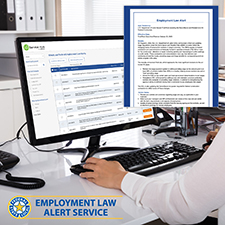
Whether your workforce is remote, on-site or a hybrid right now, the thread that can help tie everything together is clear, concise objectives.
A good place to start is SMART goals. A longstanding component of any reputable performance management process, SMART goals help align employees with the business, outline individual expectations and allow for fairer assessment. Let’s take a closer look at how to set SMART goals and get the most value from them with your staff, no matter what the setting.
The Lasting Impact of Goal Setting
Any business can benefit from establishing specific, measurable goals with employees and monitoring their progress toward those goals. Thoughtful employee goal setting can:
- Connect employees to the bigger picture, which is especially important with remote workers
- Identify the roles employees play with higher-level company objectives
- Boost alignment and enhance synchronicity with teams and departments
- Foster greater employee engagement and motivation
- Encourage self-discipline and reduce the need to micromanage employees
- Create fairness and consistency in how performance is rated
The power of SMART goals is a simple, straightforward formula. Set your business up for success with goals that are Specific, Measurable, Attainable, Relevant and Timebound.
What Are the Key Components of SMART Goals?
First things first: You should involve your employees in the goal creation process, as it gives them a degree of ownership over their jobs – and, ultimately, their success.
Similarly, employees indicate where their interests and strengths lie when they participate in goal setting, which helps you see where to focus your efforts to increase productivity overall.
As a framework, goals should be SMART. This is an acronym for:
- Specific: The goal involves a precise accomplishment or task
- Measurable: The goal includes a metric, survey or audit to determine its success
- Achievable: The goal increases employee output but is entirely possible with the proper skills and resources
- Relevant: The goal ties into broader company plans or objectives
- Timebound: The goal has a clear timeframe and/or end date
How to Balance Core and Stretch Goals Effectively?
Beyond the S-M-A-R-T framework, another important consideration is the balance of core and stretch goals. You want goals to be bold enough to motivate employees and boost their performance. But if employee goals are too aggressive, employees can get discouraged and disengage. Set a handful of primary core goals, but only one or two more far-reaching stretch goals per year.
If you have multiple stretch goals that must be met for the year, consider doling them out to a team rather than a single employee. Meeting stretch goals is easier when they’re shared. Group core goals also encourage employees to work together, which can strengthen teams and departments. It can help, too, to break down stretch goals into smaller sub-goals to make them more achievable over time and easier to monitor.
One final recommendation is to incorporate your company mission statement or core values into employee goals. Weaving these values into your employees’ performance can make your workforce feel more unified and purposeful.
Tips for Helping Your Team Implement Smart Goals
Implementing SMART goals effectively with your team requires building a foundation of clarity, support, and flexibility. Here are some tips to guide you:
Walk the Talk — Set personal SMART goals and hold yourself accountable, demonstrating your commitment and inspiring your team to follow suit. Be the example you expect them to see.
Provide Resources and Tools — Give your team the tools and resources they need (training, software, budget) to succeed. Anticipate and address challenges they might face along the way.
Encourage Flexibility — While SMART goals provide a framework for effective goal-setting, it's important to remain flexible and adaptable. Encourage team members to adjust their employee goals as needed based on changing circumstances
Celebrate Achievements — Recognize and celebrate every milestone, big or small. Recognition fuels motivation and reinforces positive behavior, keeping your team excited and moving forward.
How to Achieve Greater Success After Goal Setting
If you treat performance management as a once or twice a year event involving a formal appraisal process, you’re missing out on some valuable opportunities to mentor, support and empower your employees. Instead, you should:
- Provide regular, thoughtful feedback — This is beneficial for any worker, but particularly for remote workers. Since they can’t step into your office for a quick chat or guidance, they may feel detached – or tend to worry about how they’re doing. Whether via text, email or phone calls, reach out to let them know where they stand. If you need to offer constructive criticism about a work issue, do so. And if things are going particularly well, be sure to extend your praise and appreciation. That being said …
- Focus on broader objectives and outcomes — As long as your remote workers are meeting the agreed-upon goals, trust them to monitor their own behavior and progress. After all, the best remote workers are those who are responsible and self-motivated. Take time to prioritize tasks and make remote workers accountable, but refrain from micromanaging. Keep your attention on the ultimate objectives, rather than day-to-day (or hour-to-hour) activity.
Address Every Performance Priority with Our Fill-and-Save™ Form Library
Businesses are functioning differently today. To help manage the legalities and keep organized under evolving conditions, take advantage of convenient, web-based HR solutions.
Fill-and-Save™ HR Form Libraries are an effective way to handle the shifting dynamics of your workplace, including performance management. The comprehensive library of forms covers your every performance management need – from establishing SMART goals and conducting self-reviews to evaluating performance and addressing any problems. Plus, each form offers the convenience of Fill-and-Save™ technology so documents can be sent electronically, and employees can complete them by typing directly into fillable fields.






 Shopping cart
Shopping cart













